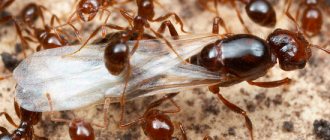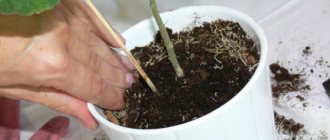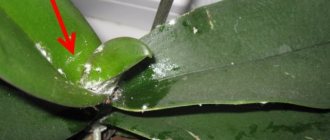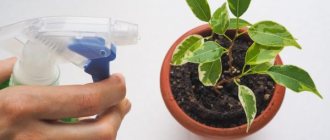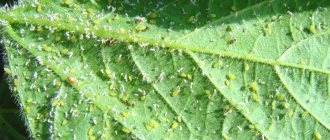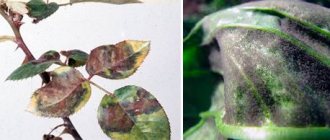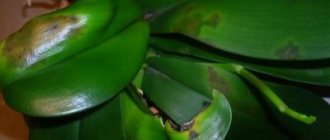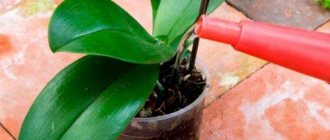White mold (Mucor)
Mold fungi grow and multiply on the surface of the soil, food products, and organic waste.
Some Mucor species are capable of causing human disease. And some species are used to produce antibiotics.
White mold on the soil in a pot does not bring any benefit; on the contrary, it can be dangerous. In appearance, it resembles white fluff, gradually filling the soil surface. To the touch, the structure is soft, easily crushed with your fingers.
It negatively affects the well-being of people and plants. Mucor will not cause any significant harm to most healthy people. But during sporulation, microscopic fungal spores entering the respiratory tract can cause an allergic reaction.
It is not so much the mold itself that harms a house plant, but the conditions under which it develops. It appeared because the rules for keeping flowers were violated.
Favorable conditions for spore germination, such as high humidity at low temperatures, heavy soils, negatively affect the development of crops. Therefore, the appearance of Mucor is not the cause of the depressed state of the plant, but a result that signals a deterioration in conditions.
Methods of disposal
In order to eliminate fungus in flower pots, the following measures must be taken:
- Replace the top layer of soil, approximately 2 - 3 cm deep, with fresh soil of a lighter structure.
- Reduce the number of waterings.
- Prevent water stagnation.
- Provide drainage.
- Loosening will saturate the soil with oxygen.
- Antifungal drugs - fungicides. For medicinal as well as preventive purposes, the ground is periodically watered with a solution of Fitosporin. It is absolutely safe, as it is a remedy for mold of biological origin.
How to get rid of mold
Purchased funds
To combat fungal infections, commercial drugs are used.
- Sarfun 500 sc. Available in the form of a concentrated suspension. Produced in Poland. Recommended in our country. It is a broad-spectrum fungicide. You can spray plants with it. This is especially good to do during the growing season. Has a healing effect. Can be used for preventive purposes. Safe for escapes and the environment. Has a long-lasting protective effect of up to four weeks. Does not wash off when spraying a flower. Easy to use. It acts on the parasite and causes disruption of fungal metabolism a few hours after treatment. The procedure is best carried out in the morning and evening hours. When processing, you must try not to get the drug on the mucous surface and protect your eyes.
- Topsin M. Systemic contact drug, which is classified as a fungicide. It is used as prophylaxis and for medicinal purposes. It copes with fungal infection and parasites: aphids, leaf beetles, lacewings. Available in powder form, which dissolves well in liquid. It can also be in the form of an emulsion. The active substance is topsin. In the preparation, its content reaches 70 percent in powder and 50 percent in emulsion. It inhibits the growth of fungal spores. Penetrates into the roots. Has a beneficial effect on diseased shoots. Completely affects parasites and blocks their development. After treatment, the plant begins to grow well and stretches out. The product begins to act within the first day. Treatment is carried out during the growing season. The plant is re-treated after two weeks. There are analogues of the above-described drugs: fungitis Azofos, Tiovit Jet.
- Azophos. Highly effective product. Actively fights fungal infection. It not only attacks fungi, but also provides nutrition to a weakened plant. Nourishes and promotes growth. It contains important microelements: nitrogen, phosphorus, etc. Reminds the effect of Bordeaux mixture. Destroys fungal spores.
Topsin M may be addictive.
Soluble salts - efflorescence
Any water used for irrigation contains soluble salts. Their concentration varies: hard or well water contains a large amount of salts. The smallest amount of elements contains rain, melt, and so-called “soft” water. Depending on the microelements present, the color of the efflorescence will differ: calcium salts will give a white tint, and if there is an excess of iron, the soil on top will be yellow or brown.
This phenomenon most often affects heavy soils with poor drainage and frequent surface watering. When water does not completely wet the earthen ball, soluble salts do not reach the roots well and linger on the surface.
Overly fertilized soil can also cause efflorescence. If microelements do not have time to be absorbed by the flower, they begin to come to the surface.
How to deal with salt deposits
In order to get rid of plaque, eliminate the cause of its appearance:
- Carefully replace the top layer of soil.
- If possible, use soft water: rain or tap water, well settled.
- Reduce the frequency of watering by increasing the volume of liquid so that the earthen ball is completely saturated.
- Ensure good drainage and clear clogged drainage holes.
- Regularly loosen the top layer of soil.
How to distinguish mold from efflorescence
The fungus protrudes a few millimeters above the soil surface, its structure is soft, delicate, and can be easily rubbed between the fingers.
Efflorescence resembles a thin coating that is difficult to separate from the soil and feels rough to the touch.
How to soften water for watering flowers
The easiest way is to collect rainwater. But this option is not suitable for industrial areas, since raindrops will collect dust and chemical elements in the air.
- Use well-settled water. For watering, take the top layer, excluding shaking.
- Filtered water. There are special filters for hard water that soften it by retaining calcium salts.
- Melt water. Take regular tap water out into the cold or place it in the freezer. Liquid without salts freezes earlier; complete freezing should not be allowed. Then the unfrozen water is drained and the ice is defrosted. The water prepared in this way will be soft and biologically active – “alive”.
- It is good to use aquarium water for watering. But provided that no drugs or other additives were added to it.
Causes of mold
The main cause of mold is a fungal infection, but a fertile environment for it is created by the grower’s inadequate care of the plants, which creates all the conditions for the development of pathogenic microorganisms. The main factors in the formation of flower disease:
- Quite low temperature in the room.
- High humidity, it is in a humid environment that fungal organisms instantly multiply.
- Insufficient water circulation in the pot.
- Frequent uncontrolled watering, you need to know the amount of liquid for each type.
- The quality of the soil, its increased acidity or heaviness, helps the development of the fungus.
Folk methods of dealing with various raids
Folk remedies involve the use of safe methods:
- Replanting the plant or replacing the top layer of soil.
- Using a weak solution of potassium permanganate. This method is effective only against mold, since potassium permanganate has fungicidal (antifungal) properties.
All types of molds, efflorescence, moss, appear on dense, poorly drained soils. Improving the soil structure, loosening, and regulated watering will help prevent this problem.
Types of mold in flower pots
There are a huge number of varieties of mold fungi. Representing colonies developing from spores, they are constantly present in the air. As soon as the necessary humidity and temperature are created, fungi begin to develop at breakneck speed. To understand the situation, let's look at the most common types of mold.
Black mold
In fact, it can take on different shades. It loves moisture very much and can develop not only on materials, but also on products. Certain types of mushrooms of this family are even used in the pharmaceutical industry. The most unpleasant for humans, it can cause allergies and breathing problems. Very common indoors.
White mold
This family is most often found on soil, trees, plants, and sometimes on bread. Flower pots are one of the best environments for these fungi. It is necessary to distinguish salt deposits from mold; the first has a crystalline form, while the second is easily kneaded in the hands.
Blue fungi
These microorganisms are especially harmful to tree fiber. By corroding the wood from the inside, they completely decompose the wood species. They have a specific pale blue color.
Actinomycetes
They resemble algae and greatly soften the wood. It is important to distinguish them from other species in order to fight in the most effective way, because each family has its own poison.
Efflorescence
The most common type of mold, which is a salt or alkaline coating that has a white, sometimes colored tint. It is dangerous because it crystallizes not only on the surface, but also inside the environment.
Soil disinfection
You can fight infection and the smell of mold in another way - by disinfecting the soil.
The instructions for performing this procedure are as follows:
- Remove contaminated soil from the roots of the plant, clearing them as much as possible from the soil.
- Transfer the collected soil to another container.
- Pour boiling water over the ground.
- Heat the oven to 200 degrees and roast the earth in it for 20 minutes.
- Wait until the soil cools completely.
- Treat the old pot with special disinfectants or also bake it in the oven (ceramics).
- Pour soil into the pot and plant the plant.
Some gardeners disinfect the soil using a water bath.
You can also steam the soil in a water bath. To do this, you need to take a pan of water, place a sieve or colander on it, and put gauze folded in several layers on top. When the water boils, you need to pour in a portion of soil and close the lid. The steaming procedure can vary from 30 minutes to an hour and a half, depending on the amount of soil poured. After all the soil has been steamed, it needs to be allowed to cool and “breathe.”
[adsp-pro-6]
Before returning the soil back to the pot, you need to add some mineral fertilizers to it, perhaps ordinary yeast. The pot must also be disinfected.
Danger of molds
The development of mold fungi leads to the formation of soil compactions, loss of air exchange, and processing of plant roots into food for mycelium. Plants can resist for a long time, they get sick, their leaves turn yellow, but the end is always the same. In the confrontation, mold wins and the infected plant dies.
You can try to save the plant by cauterizing the affected area with potassium permanganate or pouring antiseptics into the soil, but the likelihood of victory in most cases is low. It is necessary to change the soil, change the pot, cut off the affected part of the plant and re-root.
Not all types of mold are harmless to humans. Particles of mycelium, fungal spores are a powerful allergen that can seriously affect health, weaken the immune system, provoke a chronic runny nose, bronchitis, and increase the tendency to colds.
Dandruff on the head and skin of a person is also caused by mold fungi. If mold is not combated with the most active and irreconcilable methods, mycoses are inevitable.
With reduced immunity, mold fungi can develop activity inside the body of humans and animals. Mold also successfully affects aquarium fish, reptiles and amphibians.
Why does mold form in a pot?
As mentioned above, there are a sufficient number of different types of fungus:
- Black mold. Most often it affects the walls and ceiling of a house or apartment.
- Blue mold. Mainly attacks wooden products.
- Mold rotting. It can occur both in wood and in ordinary food products.
- White mold. This is what appears on flower pots. Because of it, the ground under the flower is covered with characteristic light or grayish spots.
If a whitish coating appears on the pot or directly on the soil under the flower, it is necessary to take appropriate steps to eliminate it as quickly as possible.
The main reason for this situation remains excessive watering.
When a flower receives too much water, it does not always have time to absorb it in time. Then another watering occurs, again and again. The constant accumulation of excessive moisture, insufficient drainage and blockage of the lower holes in the pot lead to the creation of a favorable microclimate under the plant for the development of mold.
Poor air and water circulation are conditions that remain ideal for fungal growth.
However, not all white mold is harmful spores. Some of this light coating is formed after the evaporation of excessive amounts of water. Microelements settle on the pot and penetrate into the soil.
In this case, water for the plant is excess and leads to a similar result.
What does mold mean for plants?
Microscopic fungi, having settled in the soil, feed on the organic substances in it, thereby deteriorating the quality of the soil, changing the acidity of the substrate and its mineral composition. Plants are deprived of the nutrients necessary for normal functioning, which can lead to their death.
The top layer of soil affected by mold becomes covered with a dense crust, which prevents free air circulation and impairs moisture exchange in the soil. As a result, plant roots weaken and gradually rot.
In addition, fungal infections of the soil reduce the immunity of flowers and provoke the development of various diseases in them.
Prevention of mold formation
It is easier to prevent mold than to fight it. To do this you need:
- make drainage in the soil using ground gravel;
- water the flowers rarely, but abundantly;
- use filtered water;
- periodically prepare a weak solution of manganese for irrigation;
- monitor the air humidity in the room;
- dig the garlic cloves near the flower, remove them after watering and drying the soil.
As you can see, the precautions are quite simple and do not require much effort.
Pay due attention to your indoor pets; flowers are living beings for which humans are responsible.
Transplanting a plant
The most effective way to combat infection is to replant the crop. This procedure helps not only get rid of mold, but also eliminate other problems, as well as provide the plant with nutrients, because it has managed to pull out all the minerals from the old soil.
See also: What to do if mold appears in seedlings on the ground
The substrate for transplantation must be selected taking into account all the rules and requirements for a particular flower. It is important to ensure good drainage. To do this, charcoal, broken polystyrene foam or small pebbles are placed at the very bottom of the pots.
After removing the contaminated soil composition, it is recommended to wash and disinfect the pot. The permissible moisture level should also be clarified in advance for a specific crop and not exceed it.
General information about mold on seedlings
Mold is a lower plant organism that can live in soil, air, water, etc. It can spread in the form of individual microscopic branched threads of mycelium and spores.
When parts of the mycelium and spores find themselves in a favorable habitat, they begin intensive reproduction in the surface layers of the soil, in which the underdeveloped root system of seedlings is located. It is not resistant to the developing parts of the mycelium, which penetrates its vascular system.
After some time, the roots of the maturing plant begin to secrete a special substance that suppresses the proliferation of mycelium. Due to this, it loses its inhibitory property. However, if mold appears on the ground with seedlings, the gardener must promptly take appropriate measures to combat it. Otherwise, there is a possibility that the young plant will die before it has time to grow.


